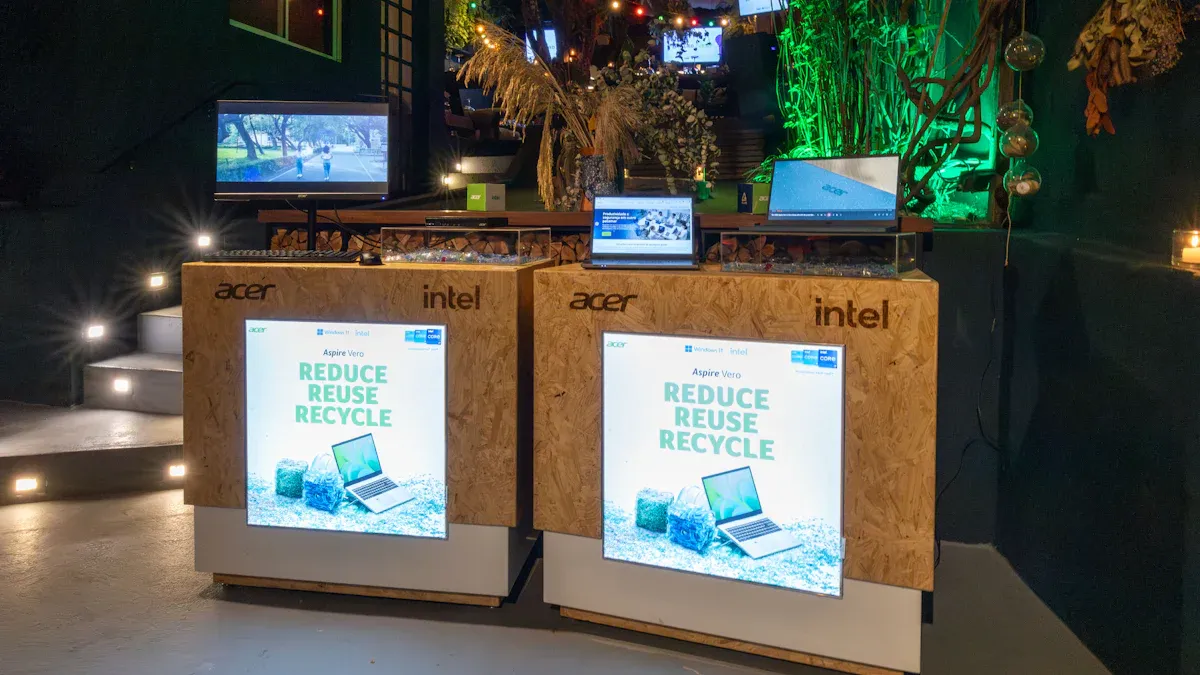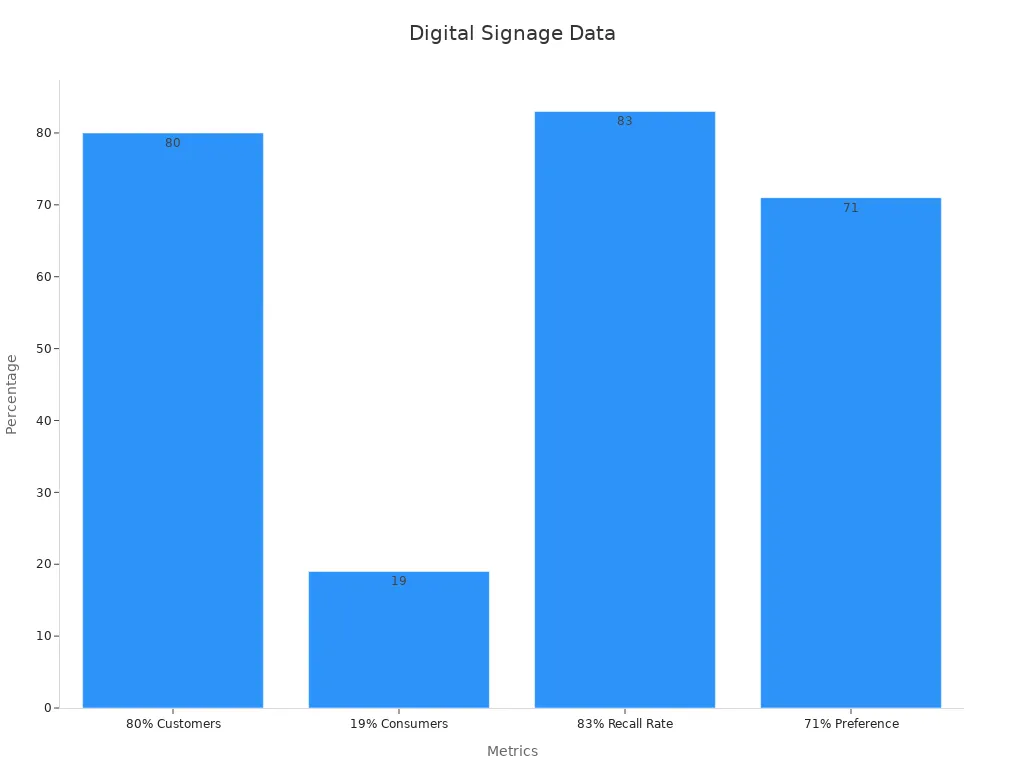Digital Signage Display Monitors: Technology, Applications, and Selection Criteria

Digital signage monitors are screens that show changing content like pictures, videos, and messages. Businesses use them to grab attention, share information, and promote their brand. You can see these screens in stores, airports, and hospitals. They make communication easier in busy places.
These screens are very important for modern advertising. In 2023, the global market for digital signage was worth $26.76 billion. Experts say it will grow by 8.1% every year from 2024 to 2030. This shows more people want tools that attract customers. Also, 94% of stores use digital screens to make shopping better, proving how popular this technology is.
Key Takeaways
Digital signs are important for modern ads. They help businesses get attention and share info easily.
Picking the right screen—LCD, LED, or OLED—depends on what you need, like price, brightness, or colors.
Clear pictures, bright screens, and touch features make digital signs better and more fun to use.
Software is needed to control digital signs. It helps update info quickly and manage content well.
New ideas like smart AI and being eco-friendly are changing digital signs, making them smarter and greener.
Technology Behind Digital Signage Displays

Types of Digital Signage Displays: LCD, LED, and OLED
It’s important to know the differences between LCD, LED, and OLED screens. Each type has its own strengths and weaknesses, making them better for certain uses.
Feature | LCD | LED | OLED |
|---|---|---|---|
Backlight | Needs a backlight | Uses LED backlight | No backlight needed |
True Blacks | No (light leaks through) | No (still uses backlight) | Yes (pixels turn off fully) |
Viewing Angles | Limited | Better than LCD | Very wide |
Color Accuracy | Okay | Good | Excellent |
Cost | Cheaper | Costs more than LCD | Most expensive |
Lifespan | Average | Long-lasting | Shorter (can burn out) |
Energy Efficiency | Less efficient | More efficient | Depends on use |
LCD screens are popular because they are affordable and work well. LED screens are brighter and save energy, so they’re great for outdoor signs. OLED screens show amazing colors and deep blacks but cost more and don’t last as long. Comparing these features helps you pick the right screen for your needs.
Key Features of Digital Signage Displays: Resolution, Brightness, and Interactivity
Three main things affect how well digital signage works: resolution, brightness, and interactivity. These features decide how much attention your screens get.
Metric | Description |
|---|---|
Resolution | Makes images sharper; higher resolution means clearer pictures. |
Brightness | Helps people see the screen in any light. |
Interactivity | Lets users interact, making the experience more engaging. |
High resolution makes your content look clear and professional, especially on big screens. Brightness is key for outdoor signs where sunlight can make screens hard to read. Interactive screens let people touch and explore, like in stores or hospitals.
Tip: Interactive screens not only grab attention but also collect useful data. This data helps improve your content and strategies.
Software Integration in Digital Signage Displays
Digital signage isn’t just about the screens. Software makes them more useful by letting you control content, schedule updates, and track performance.
Here are some examples of how software helps:
Case Study | Environment | Key Outcomes |
|---|---|---|
Interactive Directory Software | Hospitals | Easier navigation, better patient experience, smoother operations |
Digital Signage Solutions | Retail | More customer interest, easy to scale, clear communication |
Digital Wayfinding Technology | Offices | Better navigation, live updates, flexible content management |
For example, in stores, software lets you change ads quickly to stay up-to-date. In offices, wayfinding tools help visitors find their way. The right software makes your digital signage system work smarter and meet your goals.
Emerging Trends in Digital Signage Technology
Digital signage is changing fast, bringing new ideas to improve its use. Knowing these trends helps you choose better digital signage solutions.
1. AI-Driven Analytics for Smarter Content
AI is changing how digital signage works. It uses data to improve content by studying how people react to it. For example, AI can see which ads get the most attention and change them instantly. This helps screens show messages that match what viewers like.
Note: Custom messages make people pay more attention and help businesses earn more from their digital signage.
2. Real-Time Updates and Targeted Messaging
Businesses now want screens that update quickly and show specific messages. This is useful in busy places. Stores use digital screens to show sales or deals right away. Schools use them to share live updates like event times or emergency alerts.
3. Increased Adoption in Education
Schools and colleges are using digital signage more than ever. They use screens for learning, guiding students around campus, and promoting events. This shows how important digital tools are for making learning fun and easy.
4. Integration of Advanced Technologies
New tech like augmented reality (AR) and virtual reality (VR) is being added to digital signage. AR screens let people interact with virtual items, making experiences exciting. For example, a store can use AR to show how clothes look on someone without trying them on. These features make screens more fun and memorable.
5. Sustainability and Energy Efficiency
Many businesses now care about saving energy and being eco-friendly. LED and OLED screens use less power, cutting costs and helping the planet. Some companies even use solar-powered screens outside to stay green.
Tip: Picking energy-saving screens helps save money and supports eco-friendly goals.
6. Growth in the Digital Signage Market
The digital signage market is growing fast because more industries are using it. Stores, hospitals, schools, and offices are driving this growth. This shows how useful digital signage is for sharing information in different places.
By learning about these trends, you can use digital signage in smart ways. Whether you want to attract customers, work more efficiently, or go green, these new ideas can help you succeed.
Applications of Digital Signage Displays

Retail Applications of Digital Signage
Digital signage has changed how stores connect with customers. These screens show sales, new products, and create fun shopping experiences. Interactive displays let shoppers see product details or check stock easily.
Studies prove digital signage works well in stores:
Statistic | Description |
|---|---|
80% of Customers | Visit stores after seeing digital signage, showing its power to attract people. |
19% of Consumers | Buy items on impulse because of digital signage, showing its impact on decisions. |
83% Recall Rate | Shoppers remember digital signage ads, making messages stick. |
71% Preference | People notice digital signage more than online ads, increasing interest. |

Using digital signage in stores helps grab attention and boost sales. These screens make shopping better and give businesses clear results.
Healthcare Applications of Digital Signage
Hospitals use digital signage to share updates and help patients. These screens show health tips, guide visitors, and reduce confusion. For example, wayfinding screens help patients find departments faster, lowering stress.
Research shows digital signage helps in healthcare:
Statistic Description | Impact on Patient Engagement |
|---|---|
Real-time updates and health information | Makes patients feel more connected and informed. |
Decrease in perceived wait times by 35% | Helps patients feel less anxious and more relaxed. |
Increased patient satisfaction with wait time info | Gives patients a sense of control and comfort. |
Healthcare providers use these screens to share important messages quickly. Whether it’s wait times or emergency alerts, digital signage ensures clear communication.
Education Applications of Digital Signage
Schools use digital signage to share news, promote events, and improve learning. Interactive screens in classrooms make lessons fun with videos and pictures. These displays also help students and visitors find their way around big campuses.
Digital signage is great for safety too. Schools use them to show emergency alerts and keep everyone informed. These screens are flexible and work for many school needs, from teaching to announcements.
Tip: Start with a few screens in key spots to see their benefits before adding more.
Hospitality Applications of Digital Signage
Digital signage helps make guests feel welcome in hotels and resorts. These screens are used to share information, entertain visitors, and improve their stay.
How Digital Signage Helps in Hospitality:
Welcome screens greet guests, leaving a great first impression.
Displays show details about hotel services, dining, and nearby attractions.
Moving content, like special offers, keeps guests informed and entertained.
Research shows digital signage boosts guest happiness by 35% and improves hotel operations by 30%. Hotels using these tools see a 20% rise in revenue from promotions. Also, 65% of guests say these screens make their stay better.
Tip: Use touchscreens or video walls to highlight services like spa deals or restaurant specials. These features inform guests and encourage them to try more, increasing profits.
Strong digital signage screens are built to last in busy areas. Whether it’s a small hotel or a big resort, these displays help you communicate clearly and make guests happier.
Corporate Applications of Digital Signage
In offices, digital signage makes communication easier and boosts teamwork. Companies use these screens to share updates, inspire workers, and improve collaboration.
Benefits of Digital Signage in Offices:
Benefit | Percentage |
|---|---|
Boosts productivity | 86% |
Builds stronger teams | 54% |
Motivates employees | 86% |
Keeps valuable workers | 69% |
Swissport, a company using Yodeck Digital Signage, shows how these screens improve workplace communication. Office displays make sharing information easy and keep employees engaged.
Why Digital Signage Works in Offices:
Screens show live updates about company news or goals.
Break room displays inspire workers with messages or rewards.
Touchscreens help teams work together during meetings or planning sessions.
79% of people like workplace screens, and 59% think they help productivity. Leaders also find that digital signage keeps employees involved, making it a smart choice for office success.
Tip: Try a small project first to see how digital signage works in your office. Use feedback to improve and expand its use.
Selecting the Right Digital Signage Display
Picking the right digital signage screen means checking hardware, location, and software. Each choice affects how well your screens work and meet goals.
Hardware Choices for Digital Signage Displays
The hardware you pick affects how strong and useful your screens are. First, think about the type of content you’ll show. LCD screens are good for simple visuals. For big video walls, LED screens work better. Touch-screen kiosks need special equipment for interaction.
Think about where the screens will be used. Outdoor screens must handle rain, heat, and sunlight. Choose bright screens with weatherproof designs for outside use. Indoor screens need clear pictures and energy-saving features to cut costs.
Power use is also important. Energy-saving screens with auto brightness can lower bills. Make sure the screens can show HD content and work with your software easily.
Tip: Look at case studies and reviews to find trusted solutions. Providers with experience in your industry often offer better results.
Indoor vs. Outdoor Digital Menu Boards
Digital menu boards are key for restaurants and food businesses. Indoor boards show menus clearly and let you update them fast. Cloud-based systems make changing prices or deals easy.
Outdoor menu boards need stronger features. They must handle sunlight, bad weather, and vandalism. Bright screens help people see menus in daylight. Weatherproof cases protect the screens, making them great for drive-thrus or outdoor seating.
When choosing, think about your audience and location. Indoor screens focus on looks and interaction. Outdoor screens focus on being tough and easy to see.
Note: Outdoor menu boards often boost sales by grabbing attention and showing updates fast.
Software Compatibility for Digital Signage Displays
Software is important for managing digital signage. Make sure it works with common file types like videos and images. This lets you create fun and engaging content easily.
IT and marketing teams should work together during setup. IT ensures the software runs well, while marketing creates great content. After setup, check how the system works and fix problems quickly.
Cloud-based software is flexible and easy to scale. It lets you update content from anywhere, which is helpful for big businesses. For example, banks use cloud systems to show live financial updates at different branches.
Tip: Pick software that fits your needs. Easy-to-use tools and strong analytics can improve your digital signage plan.
Cost and ROI of Digital Signage Displays
Buying digital signage may seem expensive at first. However, the benefits over time often make it worth the cost. To figure out the return on investment (ROI), you need to look at both the costs and the gains.
Key Cost Components
When adding up the total cost, think about these:
Hardware: Includes screens, media players, and mounts.
Software: Lets you manage and update your screen content.
Installation: Experts set up your screens to work correctly.
Maintenance: Regular care keeps everything running smoothly.
Measuring ROI
To find ROI, use this formula:ROI = (Net Profit / Total Investment) x 100
Net profit is what’s left after subtracting costs from earnings. Total investment includes all upfront and ongoing expenses.
Steps to measure ROI:
Add up all costs like hardware, software, and maintenance.
List benefits, such as more sales or saving money on printed signs.
Use the formula to calculate your percentage return.
Benefits of Digital Signage
Digital signage has many perks that boost ROI:
Cost Efficiency: Over time, it’s cheaper than printed signs.
Revenue Generation: Ads and promotions on screens bring extra income.
Improved Customer Experience: Interactive screens keep customers engaged.
For example, linking digital signage with sales data shows its effect on profits. Surveys can also help you improve content based on customer feedback. Outdoor digital menu boards often attract more people and increase sales because they’re easy to update and highly visible.
Tip: Start small with a few screens in busy areas. Track how they perform and expand if they work well.
Maintenance and Support for Digital Signage Displays
Taking care of your digital signage is important. A well-maintained system lasts longer and works better, saving you money.
Best Practices for Maintenance
Follow these tips to keep your screens in good shape:
Regular Inspections: Look for problems like broken screens or connection issues.
Software Updates: Update your system for new features and better security.
Cleaning: Dust and dirt can block the screen. Clean it with safe materials.
Environmental Protection: Outdoor screens should handle weather and extreme conditions.
Importance of Quality Control
Good digital signage is tested before being sold. Tests include:
Durability Testing: Makes sure the hardware lasts a long time.
Performance Testing: Checks screen quality and system speed.
Environmental Testing: Ensures outdoor screens work in tough weather.
Support Services
Good support helps fix problems fast. Many companies offer 24/7 monitoring and remote help. Some also provide warranties and on-site repairs for extra peace of mind.
Note: A maintenance plan can save money by avoiding big repair costs later.
By keeping up with maintenance and choosing strong, tested screens, your digital signage will stay reliable and effective for years.
Knowing how digital signage works helps you use it better. Business screens last longer and work harder than regular TVs. They are made to run all day, connect to many devices, and can stand upright. This makes them great for workspaces.
To set up digital signage, follow these steps:
Check your space to find the best spots for screens.
Try a small project first to test how it works.
Grow your system based on what works best for your viewers.
These steps help you build a strong and fun digital signage setup that fits your needs.
FAQ
How is digital signage different from regular TVs?
Digital signage is made to work all day, every day. It connects to many devices and has features like touchscreens and scheduling. Regular TVs are for homes and don’t have these options.
Can digital signage be used outside?
Yes, outdoor digital signage is built for tough weather. These screens are brighter and have cases to protect them from rain and heat.
How do I change content on digital signage?
You can use special software to update the screens. Many systems let you make changes online, so you can do it from anywhere.
Is it costly to maintain digital signage?
The cost depends on the screen type and how it’s used. Cleaning, updates, and small repairs keep costs low. Strong screens last longer and save money over time.
Can small businesses use digital signage?
Yes! Small businesses can use it to attract customers and share deals. Start with a few screens in busy spots to see quick results.
See Also
Exploring LED Displays: Advantages, Uses, and Innovations
A Thorough Comparison of Digital Signage Display Solutions
Choosing Between Digital Signage Displays and Traditional TVs
Utilizing Digital Signage for Effective Information Sharing
Understanding Digital Window Displays: Benefits and Best Practices

